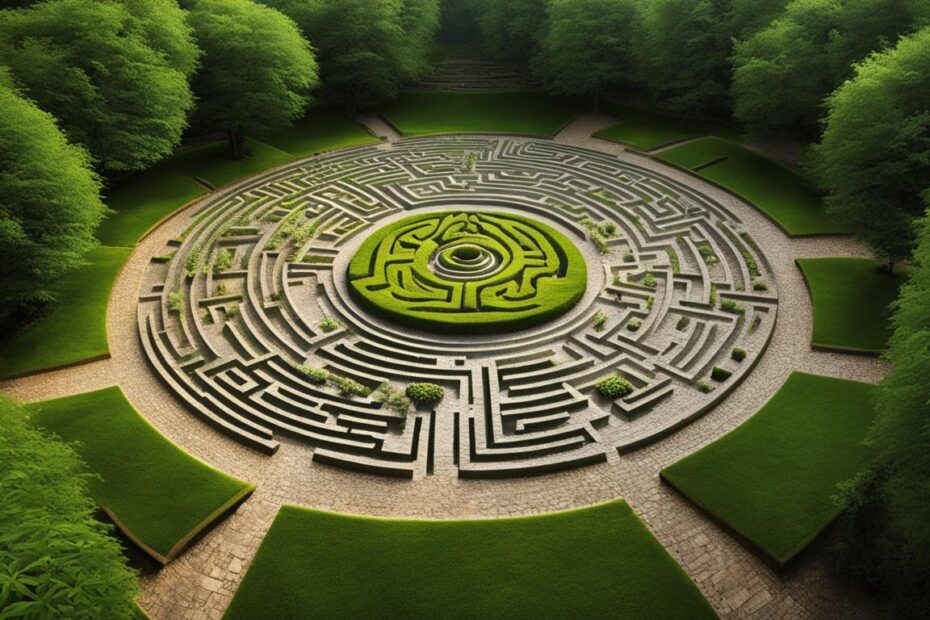Welcome to our enlightening exploration of the history of prayer labyrinths. These mystical symbols have been used by various faiths for spiritual contemplation and prayer throughout the ages. From their ancient origins to their significance in modern times, prayer labyrinths have captivated the hearts and minds of individuals seeking spiritual connection and inner peace.
Key Takeaways:
- Prayer labyrinths have a rich history and are symbols of the soul’s journey through life.
- The origins of labyrinths can be traced back thousands of years, with early depictions found in various cultures.
- In Christianity, labyrinths were integrated into practices and represented the journey of the Christian life.
- Walking a labyrinth offers a meditative and transformative experience for spiritual contemplation.
- Despite changes in their use over time, labyrinths continue to be embraced for their spiritual and contemplative nature.
The Ancient Origins of Labyrinths
Labyrinths have a fascinating history that stretches back thousands of years. These ancient structures can be traced back to various cultures, including India, Egypt, Rome, Crete, and even Arizona. The earliest rock carvings and artwork dating back 4,000 years depict labyrinths, showcasing their enduring significance throughout history.
In Greek mythology, the labyrinth was famously depicted as a maze that housed the Minotaur. The mythological tale of Theseus defeating the Minotaur in the labyrinth is often seen as a representation of the spiritual journey of conquering inner darkness. This mythological connection further emphasizes the symbolism and profound meaning associated with labyrinths.
“The labyrinth is a profound symbol, representing the twists and turns of life’s journey and the ultimate victory over challenges.” – Ancient Wisdom Magazine
Labyrinths have been embraced for their symbolic representation of the human journey and the triumph over obstacles. They serve as powerful reminders that life is a continuous path, filled with various twists and turns. The winding paths of labyrinths reflect the complexities of life, while the ultimate goal of reaching the center symbolizes the attainment of inner peace, enlightenment, or spiritual fulfillment.
| Symbolism of Labyrinths | Meaning |
|---|---|
| Maze | A representation of the challenges and obstacles encountered in life |
| Journey | The path to self-discovery, spiritual growth, or enlightenment |
| Center | Represents a state of higher consciousness, inner peace, or spiritual union |
| Winding Paths | Reflection of life’s twists and turns, encouraging contemplation and introspection |
As we delve into the historical evolution of labyrinths and their significance in different cultures and traditions, it becomes evident that these ancient structures continue to captivate and inspire individuals in the modern age.
The Christian Adaptation of Labyrinths
The use of labyrinths in Christian practices has a rich history that dates back to the 4th century. Early Christian labyrinths were found in places like the Basilica of St. Reparatus in Algeria, which featured the words “Sancta Ecclesia” (Holy Church) in the center, emphasizing their Christian significance. As Christianity spread, labyrinths became more prevalent in churches and cathedrals, serving as powerful tools for spiritual contemplation and prayer.
A defining feature of Christian labyrinths is their design, often following the medieval pattern that originated with the Chartres Cathedral labyrinth. This design features a single, winding path that leads to the center, symbolizing the journey of the Christian life. It became a substitute for pilgrimages to Jerusalem, allowing individuals to embark on a symbolic spiritual journey within the confines of their own community.
The spiritual significance of labyrinth walking in the Christian tradition is profound. Walking the labyrinth is seen as a form of active meditation, offering a physical representation of the spiritual journey. The twists and turns of the labyrinth mirror the challenges and obstacles one encounters in life, while the path leading to the center represents the ultimate goal of union with God. By engaging in this practice, individuals can experience a deep sense of connection, introspection, and spiritual transformation.
The Labyrinth at Chartres Cathedral
“Walking the labyrinth is a spiritual journey that helps me center myself and connect with God on a deeper level. It’s a beautiful practice that allows me to let go of distractions and focus on my faith.”
Overall, the Christian adaptation of labyrinths showcases their historical significance and their role as spiritual tools within the Christian faith. The labyrinth design, with its winding path and symbolic meaning, invites believers to embark on a transformative journey of faith and self-discovery. Through labyrinth walking, Christians can deepen their spiritual connection and find solace, guidance, and inspiration in their faith.
| Historical Uses | Labyrinth Design | Spiritual Significance |
|---|---|---|
| Integrated into Christian practices in the 4th century | Followed medieval pattern, exemplified by the Chartres Cathedral labyrinth | Symbolic representation of the spiritual journey and union with God |
| Prevalent in churches and cathedrals | Single, winding path leading to the center | Active meditation and deep spiritual connection |
| Substitute for pilgrimages to Jerusalem | Opportunity for introspection and spiritual transformation |
The Spiritual Significance of Labyrinth Walking
Labyrinth walking is an ancient practice used by many different faiths and spiritual traditions for spiritual centering, contemplation, and prayer. It offers a unique and meditative experience that allows individuals to embark on a sacred journey of self-reflection and transformation. The labyrinth, with its intricate patterns and winding paths, symbolizes the twists and turns of life’s journey, leading the walker to the center, where they can find a deeper connection with their spirituality.
Walking the labyrinth is a form of active meditation, where the individual follows the path at their own pace, allowing their mind to quiet and their focus to turn inward. As they navigate the labyrinth, they may experience a range of emotions and insights, leading to a greater sense of clarity and inner peace. It serves as a powerful tool for self-discovery and spiritual growth, allowing individuals to explore their beliefs, release emotional burdens, and gain a deeper understanding of themselves and their place in the world.
The spiritual significance of labyrinth walking extends beyond any specific religious or cultural tradition. It is a universal practice that transcends boundaries and invites people from all walks of life to engage in a sacred and transformative experience. Whether it be in a church, a retreat center, or an outdoor setting, labyrinth walking offers a space for individuals to connect with their inner selves, find solace in times of uncertainty, and seek guidance on their spiritual path.
Walking the labyrinth is a journey of the soul, a way of connecting with the divine and attaining a sense of inner peace and clarity. It is a practice that has been passed down through generations, reminding us of our shared humanity and our collective yearning for spiritual connection.
In summary, labyrinth walking holds a deep spiritual significance, rooted in ancient traditions and embraced by individuals and communities in the modern age. It provides a pathway for self-reflection, contemplation, and spiritual growth, inviting individuals to explore the depths of their spirituality and find solace in their journey of life.
The Historical Evolution of Labyrinth Use
Labyrinths have a fascinating history that has seen them evolve in design and purpose over time. From ancient origins to modern adaptations, the use of labyrinths has spanned cultures and served various functions throughout history.
In ancient times, labyrinths were used for more than just spiritual contemplation. They were seen as a means of protection from evil spirits and were even used in fertility rites. Ancient civilizations, such as the Egyptians and Romans, constructed labyrinths as symbols of their belief systems. These early labyrinths featured intricate designs and layouts.
As time progressed, the design and purpose of labyrinths shifted. Turf labyrinths became popular in medieval England, offering a form of entertainment for the aristocracy. Hedge mazes also gained popularity in Europe, providing an engaging experience for visitors. However, some labyrinths were met with skepticism by church officials, who saw them as distractions rather than sacred spaces.
Despite these changes, labyrinths have maintained their spiritual and contemplative nature. Today, labyrinths can be found in various forms, from traditional church labyrinths to contemporary designs in outdoor spaces. The historical evolution of labyrinth use showcases the enduring appeal and adaptability of this ancient practice.

| Time Period | Labyrinth Design | Function |
|---|---|---|
| Ancient Times | Intricate and symbolic designs | Protection from evil spirits, fertility rites, belief systems |
| Medieval Times | Turf labyrinths, hedge mazes | Entertainment, amusement |
| Modern Era | Various designs, including contemporary adaptations | Spiritual contemplation, personal reflection |
Labyrinth Walking in the Modern Age
In recent years, there has been a resurgence of interest in labyrinth walking. People from various backgrounds have embraced this ancient practice as a means of personal reflection, spiritual connection, and mindfulness. Labyrinths can now be found in a wide range of locations, including churches, spiritual retreat centers, parks, and even private gardens.
Contemporary labyrinth practices have evolved to suit the needs of modern individuals seeking spiritual growth and contemplation. Individuals and groups participate in labyrinth walks as a way to find inner peace, gain clarity, reduce stress, and enhance their overall well-being. The experience of walking the labyrinth is often described as a meditative journey that allows for deep introspection and self-discovery.
“Walking a labyrinth is like following a path to your sacred center. It’s a way to quiet the mind, connect with your inner self, and find a sense of peace and stillness amidst the chaos of everyday life.” – Jane Smith, labyrinth enthusiast
Books and lectures on labyrinth walking provide guidance and insights into the practice, offering different techniques and suggestions for incorporating it into one’s spiritual routine. This accessible and inclusive practice has attracted individuals from various religious and non-religious backgrounds, emphasizing its universal appeal and adaptability.
Benefits of Labyrinth Walking
The benefits of labyrinth walking extend beyond the immediate experience. Research has shown that engaging in this practice can have a positive impact on mental, emotional, and spiritual well-being. Some of the potential benefits include:
- Enhanced mindfulness and presence
- Stress reduction and relaxation
- Increased self-awareness and clarity
- Spiritual connection and personal growth
- Improved focus and concentration
As more individuals discover the transformative power of labyrinth walking, its popularity continues to grow. Whether seeking solace, inspiration, or a deeper understanding of oneself, the labyrinth provides a sacred space for introspection and spiritual exploration in the modern age.
| Location | Type of Labyrinth | Description |
|---|---|---|
| Grace Cathedral, San Francisco | Chartres-style labyrinth | A replica of the labyrinth found in Chartres Cathedral, France. It is one of the most renowned labyrinths in the United States, attracting visitors from all walks of life. |
| Findhorn Foundation, Scotland | Outdoor garden labyrinth | An expansive labyrinth set within the beautiful landscape of the Findhorn Foundation. It offers a serene environment for spiritual reflection and connection with nature. |
| Unity Village, Missouri | Stone labyrinth | A labyrinth made of stones, located in the peaceful grounds of Unity Village. It provides a tranquil space for contemplation and self-discovery. |
| Private Residence, New York | Backyard labyrinth | A small labyrinth created by a homeowner in their backyard. It serves as a personal sanctuary for quiet reflection and meditation. |
Conclusion
The history and significance of prayer labyrinths are rooted in ancient times, spanning centuries and cultures. These mystical pathways have served as powerful symbols and tools for spiritual contemplation and connection.
From their ancient origins to their adaptation within Christianity, labyrinths have held a deep historical significance. They have been found in various cultures, reflecting the universal longing for spiritual exploration and inner transformation.
Today, labyrinths continue to be embraced in modern times. Whether walking a labyrinth for personal reflection, seeking inner peace, or engaging in religious devotion, individuals find solace and connection within these sacred spaces. The rich history and spiritual significance of prayer labyrinths make them a fascinating subject, inviting exploration and understanding.
FAQ
What is the history of prayer labyrinths?
Prayer labyrinths have a history that dates back thousands of years. They were found in various cultures, including India, Egypt, Rome, Crete, and even in Arizona. The earliest rock carvings and artwork, dating back 4,000 years, depict labyrinths.
What is the significance of labyrinths?
Labyrinths have consistently represented a path of the soul through life. They have been associated with symbolism, representing the twists and turns of life’s journey and the ultimate victory over challenges. In Christian practices, labyrinths have been interpreted as representing the journey of the Christian life or serving as a substitute for pilgrimages to Jerusalem.
What is the purpose of walking a labyrinth?
Walking a labyrinth is a form of active meditation. It allows for reflection, contemplation, and an opportunity for spiritual transformation. The experience of walking the labyrinth may vary depending on the individual, but it is often described as a meditative and calming experience.
How have labyrinths been used throughout history?
Labyrinths have taken on various forms and purposes throughout history. They have been used for religious and spiritual practices, protection from evil spirits, fertility rites, and even as amusement. Turf labyrinths became popular in England during the Middle Ages, while hedge mazes gained popularity in Europe.
Where can labyrinths be found today?
Labyrinths can now be found in various locations, including churches, spiritual retreat centers, and even outdoor spaces. Individuals and groups participate in labyrinth walks for personal reflection, spiritual connection, and mindfulness.
What is the significance of labyrinth walking in the modern age?
Labyrinth walking has experienced a resurgence of interest in recent years. It is recognized for its ability to promote relaxation, focus, and introspection. Books and lectures are available to guide individuals in exploring labyrinth walking and its potential benefits.
What makes prayer labyrinths a fascinating subject for exploration?
The rich history and spiritual significance of prayer labyrinths make them a fascinating subject for exploration and understanding. From their ancient origins to their adaptation within Christianity and their continued relevance in modern times, labyrinths have served as powerful symbols and tools for spiritual contemplation and connection.








